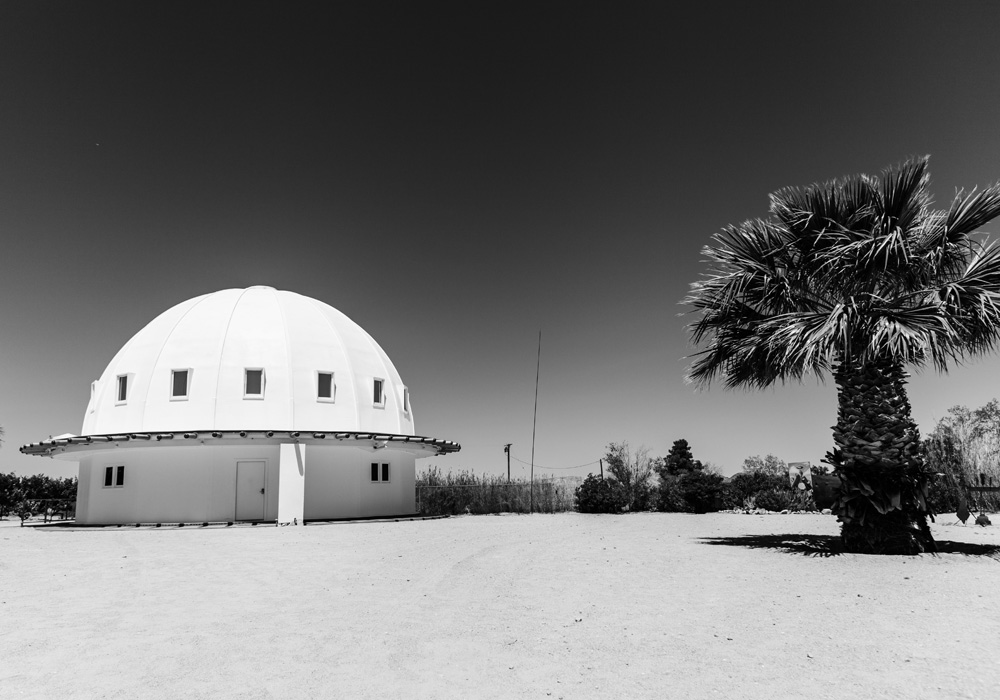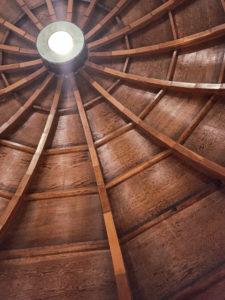A Journey into Outer Space from Within: A Visit to the Integratron
the following is a version of the story I wrote for worldfootprints about the Integratron.

I laid down on the padded mat about as close to the center of the room as I could position myself. I didn’t know what to expect. A man’s voice gave us some historical background. His skin was slightly weathered, leathery from years of desert sun. He spoke with a certainty that both charmed me and put me at ease. He did not tell us his name, only that he’d been working here for many years, first giving deep tissue massages, and now playing the quartz bowls. I closed my eyes. “You may hear water” he said “but we don’t play any kind of water soundtrack and there is no water in the room.” He began performing. 20 bowls of varying size, made from polished crystal surrounded him on one side of the dome. Approximately two dozen of us were spread out in a semi-circle around him. The low sound began to ring through me. I could feel it in my legs, in my abdomen, moving slowly into my chest. It was like a gentle, soothing vibration. As the notes changed and the vibration began to move into different places in my body, I could hear it faintly in the background. It sounded like water in a drain pipe. Circling in a funnel and moving into the ground. I’ve experienced sound baths before, but nothing like the Integratron.
When I climbed to the top of the ladder and stepped into the room, I knew this was like no other room I’d ever been in. A sort of vertically elongated dome, the diameter of the building is 55 feet. Acoustically perfect, it is designed so that a person standing on one side of the room can whisper and the person directly opposite from them, 50 feet away, can hear them clearly. Due to a phenomena called geometric shadow, if one of them steps 3 inches to either side, they can only see the person in front of them whispering. They can’t hear anything. Sound created at the center of the dome reverberates strongly and clearly throughout. Upon testing this, I found myself giggling like a child. Feeling suddenly sheepish, I quickly stepped away in self-conscious discomfort. I watched as others did the same.
Primarily made of wood, the Integratron is comprised of sixteen curved, laminated beams that stretch from its base to a one-ton concrete porthole at the apex of the dome. There are no ferrous screws or hardware in the Integratron as its creator George Van Tassel believed that ferromagnetic metals would dampen the frequency, thus dampening it’s therapeutic effect. He designed the dome based on something called a Multiple Wave Oscillator which is a combination of a high voltage Tesla coil, and a split-spring resonator that generates wideband electromagnetic frequencies. Van Tassel also believed that the structure’s location was paramount to its efficacy. The exact location is purported to be a powerful geomagnetic anomaly that includes a convergence of as many as three underground rivers and other geologic ley lines. This is a place where physical aberrances can happen without explanation; like Sedona, AZ or the Bermuda triangle.

First conceptualized in 1953, the Integratron’s construction began in 1957 and took more than 20 years to complete. Van Tassel claimed the idea came to him through an alien contact experience. He claimed he’d been visited by a space craft in the desert near his home at Giant Rock, CA. As he retold the story, he communicated telepathically with the outer space beings who gave him a formula for a frequency that could repair living tissue. Van Tassel believed that aliens were making contact with him so that he could spread a message. A message that transcended language and could benefit humanity. A message that could heal us; save us from ourselves. He believed he had a method that would allow us to travel through time and space and make us more perfect versions of ourselves.
Van Tassel hosted weekly meditations here for years before his 1953 contact with a being allegedly from Venus. Earlier that year, Van Tassel hosted the first Interplanetary Spacecraft Convention at his small airstrip near Giant Rock. This was the first of 25 annual UFO conventions he held there. These became the vehicles for funding the construction of the Integratron.
Van Tassel was among at least half a dozen other men who formed non-sectarian UFO religions; all based on alien contact experiences they’d allegedly had in the Mojave desert and across the southwestern US in the 1950s. Unfortunately, his timeline is suspect. He opens what he calls his “Interplanetary Airport” in 1947. He starts his meditations and then a UFO convention in 1953 and serendipitously has a contact with a being from Venus later that year. There were no witnesses.

Its awfully convenient, but should that matter? Can the Integratron actually heal anyone or allow them to travel through space and time? Modern science would say that its not possible, but who knows? Claims made by the owners and operators of the Integratron say that scientific tests have been done and that science itself cannot explain the resulting measurements of increased electromagnetic energy at the center of the structure. The original Multiple Wave Oscillator was designed for and used to treat cancer in the early 1900s. It’s creator allegedly had some success, curing his own cancer, and the device is still used as a form of alternative medicine. Van Tassel’s claims may be somewhat dubious, but they’re undeniably interesting.
Does it matter if the claims are untrue? The experience of the Integratron is individual. What I experienced there was different from the person with me. And while there were some common themes, there are reports of people who’s experiences differ widely. Just because the claims of purpose or origin are somewhat suspicious, its still worth a visit to see the structure and experience the sound bath.
While George Van Tassel may have passed from this earthly coil, his legacy lives on. The Integratron has changed ownership a few times resulting in its current more pristine, more tourist-friendly state. A visit to the Integratron allows both a short tour of the structure and its surroundings as well as an approximate 30 minute sound bath. The well-manicured oasis offers a friendly place to sit and read in a hammock or to view the collection of found hippie folk art that dot the grounds and garden. Architecturally, the flying saucer-like shape of the building is a nod to the impetus of its inception. Even if the Integratron doesn’t sit atop a powerful vortex, the historical significance ties it to the beauty of its desert surroundings and the culture of many of the people who settled in the area and made it what it is today.
